2019 HONDA CLARITY ELECTRIC heating
[x] Cancel search: heatingPage 7 of 559
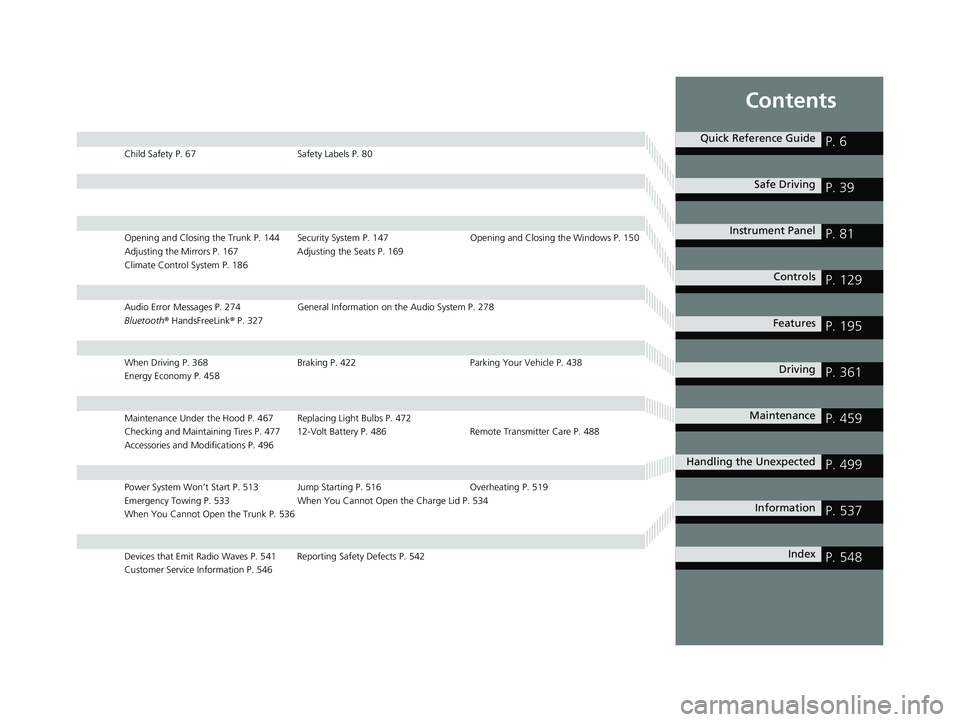
Contents
Child Safety P. 67Safety Labels P. 80
Opening and Closing the Trunk P. 144 Security System P. 147 Opening and Closing the Windows P. 150
Adjusting the Mirrors P. 167 Adjusting the Seats P. 169
Climate Control System P. 186
Audio Error Messages P. 274 General Information on the Audio System P. 278
Bluetooth ® HandsFreeLink ® P. 327
When Driving P. 368 Braking P. 422Parking Your Vehicle P. 438
Energy Economy P. 458
Maintenance Under the Hood P. 467 Replacing Light Bulbs P. 472
Checking and Maintaining Tires P. 477 12-Volt Battery P. 486 Remote Transmitter Care P. 488
Accessories and Modifications P. 496
Power System Won’t Start P. 513 Jump Starting P. 516 Overheating P. 519
Emergency Towing P. 533 When You Cannot Open the Charge Lid P. 534
When You Cannot Open the Trunk P. 536
Devices that Emit Radio Waves P. 541 Reporting Safety Defects P. 542
Customer Service Information P. 546
Quick Reference GuideP. 6
Safe DrivingP. 39
Instrument PanelP. 81
ControlsP. 129
FeaturesP. 195
DrivingP. 361
MaintenanceP. 459
Handling the UnexpectedP. 499
InformationP. 537
IndexP. 548
19 CLARITY BEV-31TRV6200.book 5 ページ 2018年10月29日 月曜日 午前10時54分
Page 21 of 559
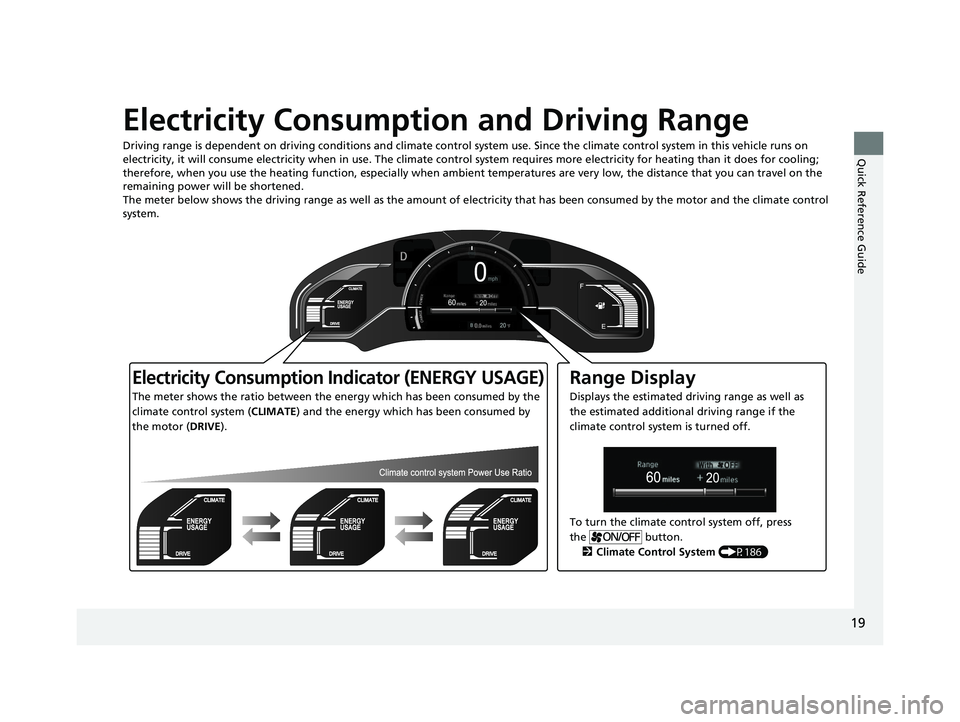
19
Quick Reference Guide
Electricity Consumption and Driving Range
Driving range is dependent on driving conditions and climate control system use. Since the climate control system in this vehicle runs on
electricity, it will consume electricity when in use. The climate control system requires more electricity for heating than it does for cooling;
therefore, when you use the heating function, especially when ambient temperatures are very low, the distance that you can travel on the
remaining power will be shortened.
The meter below shows the driving range as well as the amount of electricity that has been consumed by the motor and the climat e control
system.
Electricity Consumption Indicator (ENERGY USAGE)
The meter shows the ratio between the energy which has been consumed by the
climate control system ( CLIMATE) and the energy which has been consumed by
the motor ( DRIVE).
Range Display
Displays the estimated driving range as well as
the estimated additional driving range if the
climate control system is turned off.
To turn the climate control system off, press
the button. 2 Climate Control System (P186)
19 CLARITY BEV-31TRV6200.book 19 ページ 2018年10月29日 月曜日 午前10時54分
Page 37 of 559
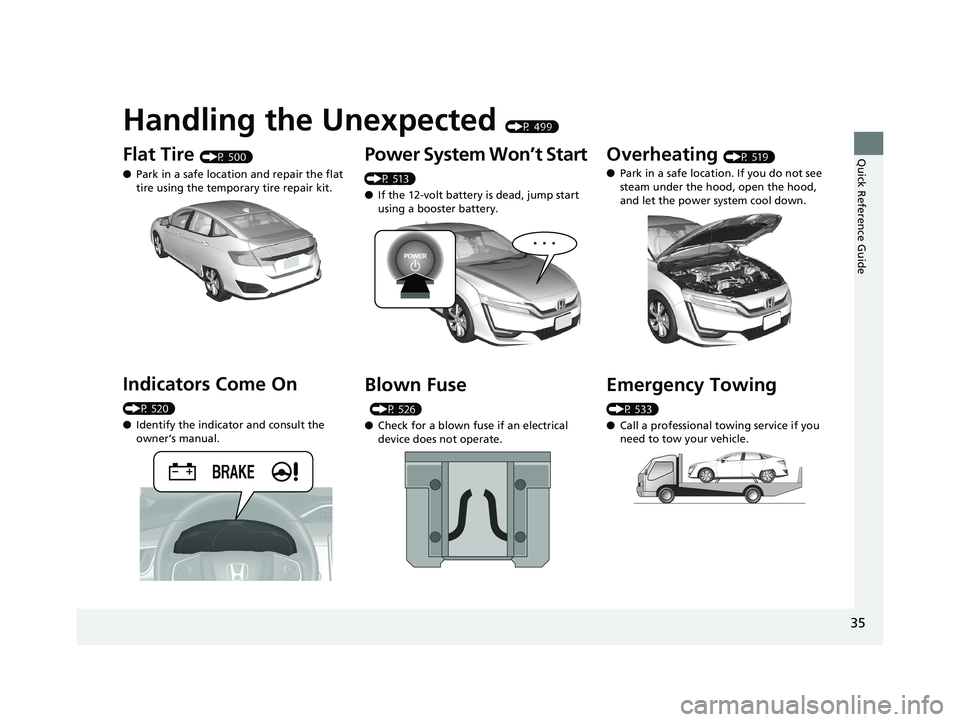
Quick Reference Guide
35
Handling the Unexpected (P 499)
Flat Tire (P 500)
● Park in a safe location and repair the flat
tire using the temporary tire repair kit.
Indicators Come On
(P 520)
●Identify the indica tor and consult the
owner’s manual.
Power System Won’t Start
(P 513)
● If the 12-volt battery is dead, jump start
using a booster battery.
Blown Fuse
(P 526)
● Check for a blown fuse if an electrical
device does not operate.
Overheating (P 519)
● Park in a safe location. If you do not see
steam under the hood, open the hood,
and let the power system cool down.
Emergency Towing
(P 533)
●Call a professional towing service if you
need to tow your vehicle.
19 CLARITY BEV-31TRV6200.book 35 ページ 2018年10月29日 月曜日 午前10時54分
Page 165 of 559
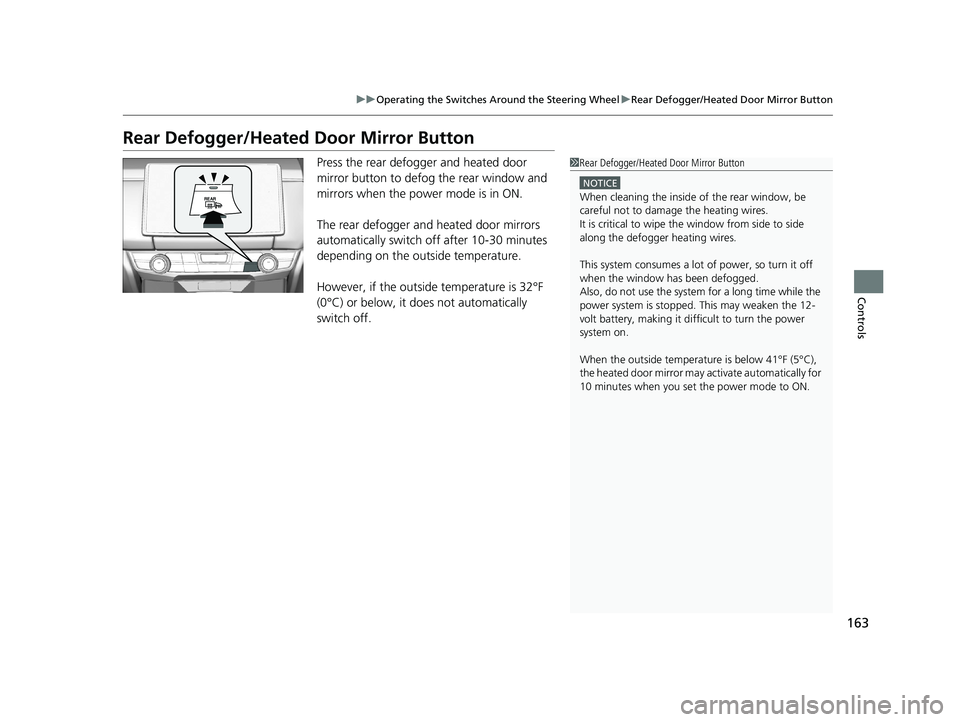
163
uuOperating the Switches Around the Steering Wheel uRear Defogger/Heated Door Mirror Button
Controls
Rear Defogger/Heated Door Mirror Button
Press the rear defogger and heated door
mirror button to defog the rear window and
mirrors when the power mode is in ON.
The rear defogger and heated door mirrors
automatically switch off after 10-30 minutes
depending on the outside temperature.
However, if the outside temperature is 32°F
(0°C) or below, it does not automatically
switch off.1 Rear Defogger/Heated Door Mirror Button
NOTICE
When cleaning the inside of the rear window, be
careful not to damage the heating wires.
It is critical to wipe the window from side to side
along the defogger heating wires.
This system consumes a lot of power, so turn it off
when the window has been defogged.
Also, do not use the system for a long time while the
power system is stopped. This may weaken the 12-
volt battery, making it di fficult to turn the power
system on.
When the outside temperature is below 41°F (5°C),
the heated door mirror may activate automatically for
10 minutes when you set the power mode to ON.
19 CLARITY BEV-31TRV6200.book 163 ページ 2018年10月29日 月曜日 午前10時54分
Page 456 of 559
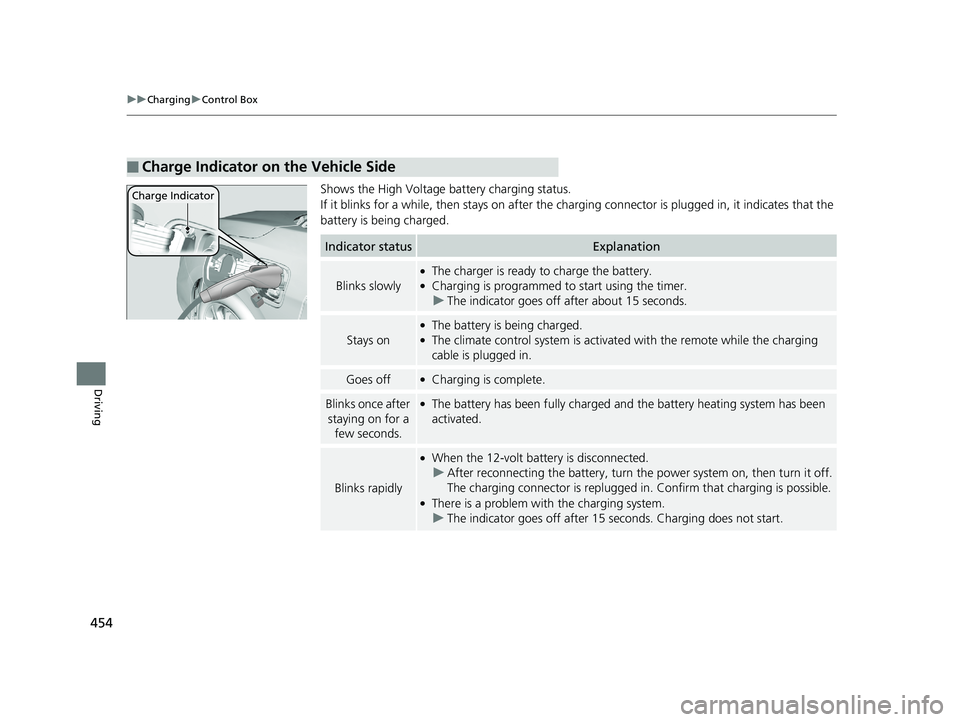
454
uuCharging uControl Box
Driving
Shows the High Voltage battery charging status.
If it blinks for a while, then st ays on after the charging connector is plugged in, it indicates that the
battery is being charged.
■Charge Indicator on the Vehicle Side
Charge Indicator
Indicator statusExplanation
Blinks slowly
●The charger is ready to charge the battery.●Charging is programmed to start using the timer. u The indicator goes off after about 15 seconds.
Stays on
●The battery is being charged.●The climate control system is activate d with the remote while the charging
cable is plugged in.
Goes off●Charging is complete.
Blinks once after
staying on for a few seconds.●The battery has been fully charged and the battery heating system has been
activated.
Blinks rapidly
●When the 12-volt batte ry is disconnected.
u After reconnecting the batt ery, turn the power system on, then turn it off.
The charging connector is replugged in . Confirm that charging is possible.
●There is a problem with the charging system.
u The indicator goes off after 15 seconds. Charging does not start.
19 CLARITY BEV-31TRV6200.book 454 ページ 2018年10月29日 月曜日 午前10時54分
Page 479 of 559
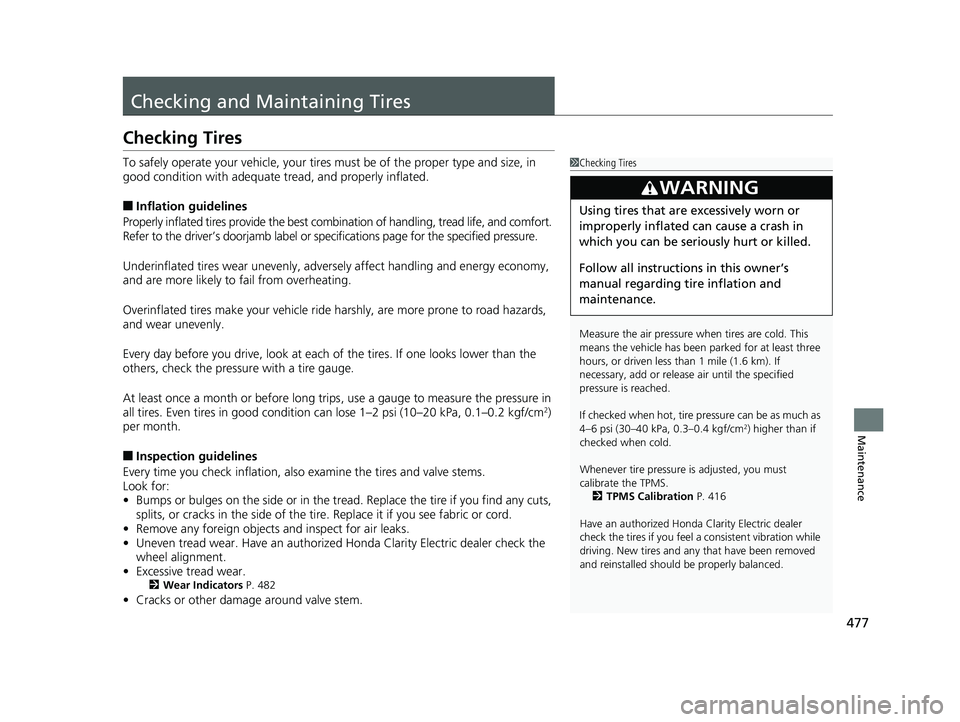
477
Maintenance
Checking and Maintaining Tires
Checking Tires
To safely operate your vehicle, your tires must be of the proper type and size, in
good condition with adequate tread, and properly inflated.
■Inflation guidelines
Properly inflated tires provid e the best combination of hand ling, tread life, and comfort.
Refer to the driver’s doorjamb label or spec ifications page for the specified pressure.
Underinflated tires wear unevenly, advers ely affect handling and energy economy,
and are more likely to fail from overheating.
Overinflated tires make your vehicle ride ha rshly, are more prone to road hazards,
and wear unevenly.
Every day before you drive, look at each of the tires. If one looks lower than the
others, check the pressure with a tire gauge.
At least once a month or before long trips , use a gauge to measure the pressure in
all tires. Even tires in good condition can lose 1–2 psi (10–20 kPa, 0.1–0.2 kgf/cm
2)
per month.
■Inspection guidelines
Every time you check inflation, also examine the tires and valve stems.
Look for:
• Bumps or bulges on the side or in the tr ead. Replace the tire if you find any cuts,
splits, or cracks in the side of the tire . Replace it if you see fabric or cord.
• Remove any foreign objects and inspect for air leaks.
• Uneven tread wear. Have an authorized Honda Clarity Electric dealer check the
wheel alignment.
• Excessive tread wear.
2 Wear Indicators P. 482
•Cracks or other damage around valve stem.
1Checking Tires
Measure the air pressure when tires are cold. This
means the vehicle has been parked for at least three
hours, or driven less than 1 mile (1.6 km). If
necessary, add or releas e air until the specified
pressure is reached.
If checked when hot, tire pressure can be as much as
4–6 psi (30–40 kPa, 0.3–0.4 kgf/cm
2) higher than if
checked when cold.
Whenever tire pressure is adjusted, you must
calibrate the TPMS. 2 TPMS Calibration P. 416
Have an authorized Honda Clarity Electric dealer
check the tires if you feel a consistent vibration while
driving. New tire s and any that have been removed
and reinstalled should be properly balanced.
3WARNING
Using tires that are excessively worn or
improperly inflated can cause a crash in
which you can be seriously hurt or killed.
Follow all instruction s in this owner’s
manual regarding tire inflation and
maintenance.
19 CLARITY BEV-31TRV6200.book 477 ページ 2018年10月29日 月曜日 午前10時54分
Page 501 of 559
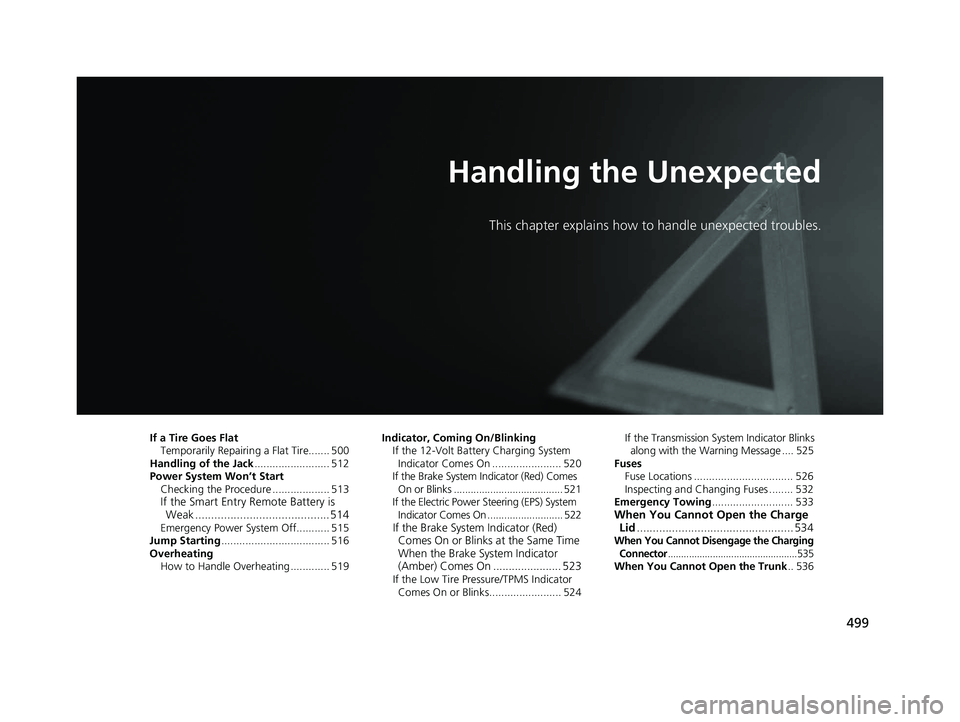
499
Handling the Unexpected
This chapter explains how to handle unexpected troubles.
If a Tire Goes FlatTemporarily Repairi ng a Flat Tire....... 500
Handling of the Jack ......................... 512
Power System Won’t Start Checking the Procedure ................... 513
If the Smart Entry Remote Battery is Weak .......................................... 514
Emergency Power System Off........... 515
Jump Starting .................................... 516
Overheating How to Handle Overheating ............. 519 Indicator, Coming On/Blinking
If the 12-Volt Battery Charging System Indicator Comes On ....................... 520
If the Brake System Indicator (Red) Comes On or Blinks ....................................... 521
If the Electric Power Steering (EPS) System
Indicator Comes On ........................... 522If the Brake System Indicator (Red) Comes On or Blinks at the Same Time
When the Brake System Indicator
(Amber) Comes On ...................... 523
If the Low Tire Pressure/TPMS Indicator
Comes On or Blinks........................ 524 If the Transmission System Indicator Blinks
along with the Warning Message .... 525
Fuses
Fuse Locations ................................. 526
Inspecting and Changing Fuses ........ 532
Emergency Towing ........................... 533
When You Cannot Open the Charge
Lid ................................................. 534
When You Cannot Disengage the Charging
Connector.................................................535When You Cannot Open the Trunk .. 536
19 CLARITY BEV-31TRV6200.book 499 ページ 2018年10月29日 月曜日 午前10時54分
Page 521 of 559
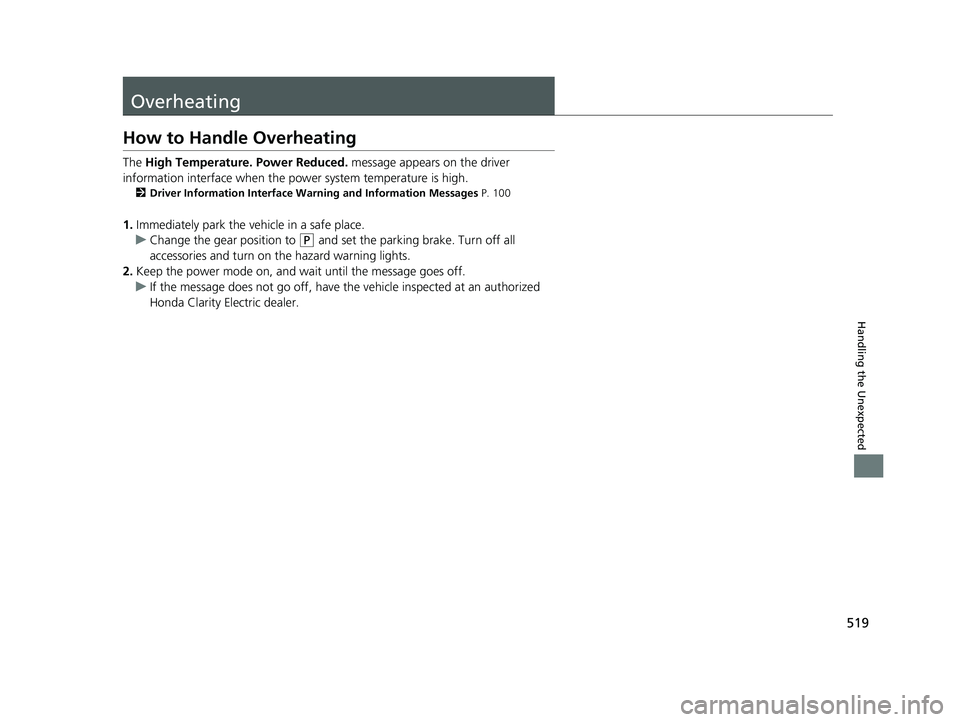
519
Handling the Unexpected
Overheating
How to Handle Overheating
The High Temperature. Power Reduced. message appears on the driver
information interface when the pow er system temperature is high.
2Driver Information Interface Wa rning and Information Messages P. 100
1.Immediately park the vehicle in a safe place.
u Change the gear position to
(P and set the parking brake. Turn off all
accessories and turn on the hazard warning lights.
2. Keep the power mode on, and wait until the message goes off.
u If the message does not go off, have th e vehicle inspected at an authorized
Honda Clarity Electric dealer.
19 CLARITY BEV-31TRV6200.book 519 ページ 2018年10月29日 月曜日 午前10時54分